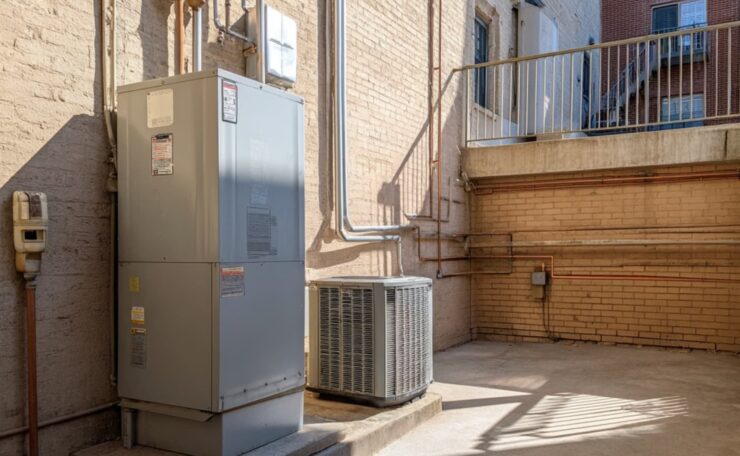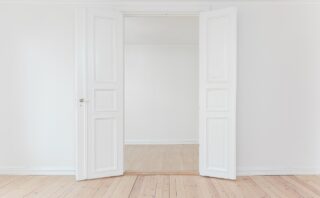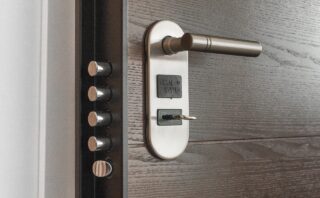Your air conditioner runs constantly through July and August, yet walking from room to room feels like moving between different climate zones. The thermostat reads 72°F, but your family room feels stuffy while the kitchen stays uncomfortably warm. Meanwhile, your energy bills climb month after month, and you’re left wondering why your cooling system seems to work harder while delivering less comfort.
This frustrating scenario plays out in thousands of homes every summer, and the culprit isn’t usually a single failing component. Instead, it’s the expensive mismatch between aging entry doors that leak conditioned air and HVAC systems forced to compensate for those losses. Most homes built before 2010 waste 25-40% of their heating and cooling energy through poor door sealing alone, while their overworked HVAC systems struggle to maintain consistent temperatures throughout the house.
Why This Combination Makes Financial Sense
The traditional approach of replacing doors and HVAC systems separately often disappoints homeowners because these components work as an integrated system. When you install energy-efficient doors on a home with an oversized, aging HVAC system, you’ve only solved half the equation. Similarly, installing a properly sized modern HVAC system while ignoring door leakage means your new equipment will still overwork to compensate for the escaped conditioned air.
Coordinated upgrades deliver measurably better results. Homeowners who replace both systems together typically see 35-45% reductions in heating and cooling costs within the first year, compared to 15-20% savings from door-only or HVAC-only upgrades. The math works because properly sealed doors allow HVAC systems to operate in their optimal efficiency range rather than constantly cycling to overcome thermal losses.
Professional HVAC contractors understand these interactions and can properly size replacement systems based on your home’s improved thermal envelope after door upgrades. Homeowners throughout Bensalem, Levittown, and surrounding Pennsylvania communities can find qualified contractors at https://regionserviceco.com/services/hvac-contractor-bensalem-pa/ who provide load calculations that account for both current conditions and planned improvements, ensuring optimal system performance and longevity.
The financial benefits extend beyond monthly utility savings. Combined upgrades typically qualify for larger rebates and tax incentives, since they demonstrate comprehensive energy efficiency improvements. Most homeowners see complete payback within 4-6 years through energy savings alone, while also gaining improved comfort and increased home value.
The Engineering Behind the Energy Loss
Door and HVAC system inefficiencies compound each other in measurable ways, affecting both comfort and operating costs. A typical entry door with worn weatherstripping and poor-fitting panels can leak 200-400 cubic feet per minute of conditioned air during peak temperature differences. To put this in perspective, that’s equivalent to leaving a window cracked open 2-3 inches around the clock.
Your HVAC system responds to this constant air loss by running longer cycles and struggling to maintain consistent temperatures. A properly sized 3-ton cooling system might run 8-10 hours daily in summer under normal conditions, but the same system, compensating for significant door leakage, could run 12-15 hours while delivering uneven cooling throughout the house.
The thermal dynamics work against comfort in multiple ways. Leaked conditioned air creates pressure imbalances that draw hot, humid outdoor air through other small gaps around windows, electrical outlets, and plumbing penetrations. Meanwhile, your HVAC system’s return air calculations become skewed, resulting in poor humidity control and hot spots in rooms farthest from the air handler.
Modern energy-efficient doors with proper weatherstripping and insulated cores can reduce air leakage by 70-85% compared to builder-grade doors from the 1990s and early 2000s. When combined with right-sized HVAC equipment that includes variable-speed components, the system can maintain precise temperature control while operating in longer, more efficient cycles rather than the short, wasteful cycles required to combat constant air loss.
When This Approach Makes Most Sense
Several clear indicators suggest your home would benefit significantly from coordinated door and HVAC upgrades. Age represents the most straightforward factor – entry doors older than 15 years and HVAC systems approaching 10-12 years have likely degraded enough that combined replacement delivers superior value compared to individual component repairs or partial upgrades.
Temperature inconsistencies between rooms exceeding 3-4°F indicate that your current systems aren’t working effectively together. Suppose you need a sweater in your home office while the kitchen feels uncomfortably warm, despite identical thermostat settings. In that case, you’re experiencing the classic symptoms of mismatched door sealing and HVAC capacity.
Rising energy costs provide another reliable indicator, especially when your usage patterns haven’t changed significantly. Homes with aging doors and HVAC systems typically see 8-12% annual increases in heating and cooling costs as components deteriorate and efficiency decreases. When repair costs for your current HVAC system exceed $800-1,000, or when door weatherstripping requires replacement every 1-2 years, coordinated upgrades become economically sensible.
Humidity problems offer the clearest signal that your door and HVAC systems need attention. Persistent indoor humidity above 55% during summer months, condensation on windows, or musty odors indicate that your current setup cannot properly control moisture levels. Modern HVAC systems paired with properly sealed doors excel at humidity management, creating healthier indoor environments while reducing energy consumption.
The Right Upgrade Sequence and Timing
The sequence of door and HVAC upgrades has a significant impact on both the installation process and the final system performance. In most cases, completing door replacements first provides the most accurate foundation for sizing and optimizing the HVAC system.
Door installations typically require 4-6 hours per entry point and create minimal disruption to your home’s heating and cooling during the work. This allows contractors to complete precise Manual J load calculations based on your home’s improved thermal envelope, ensuring the new HVAC system matches your actual heating and cooling requirements rather than compensating for air leaks that no longer exist.
Seasonal timing affects both cost and convenience. Spring installations avoid the premium pricing and extended scheduling delays common during peak summer and winter months. Door replacements can proceed in any weather, while HVAC installations work best during mild temperatures when temporary system shutdowns don’t compromise indoor comfort.
For homes requiring emergency HVAC replacement during extreme weather, temporary door improvements like professional weatherstripping and storm door installation can provide immediate relief while preserving the opportunity for proper system sizing once comprehensive door upgrades are complete.
Permit requirements vary by jurisdiction, but most areas require permits for HVAC system replacement while door replacements typically fall under standard home improvement guidelines. Professional contractors handle permit applications and coordinate inspections to ensure compliance with local building codes and manufacturer warranty requirements.
Choosing Compatible Systems
Door and HVAC system compatibility extends far beyond basic functionality to include thermal performance characteristics that affect long-term efficiency and comfort. Understanding these interactions helps homeowners make informed decisions about upgrade specifications and avoid costly mismatches.
Energy-efficient doors with insulated steel or fiberglass cores and multi-point locking systems provide consistent sealing performance that allows HVAC systems to operate in their designed efficiency ranges. Look for doors with R-values of 10 or higher and weatherstripping systems rated for wind resistance of 50 mph or higher. These specifications ensure your HVAC system’s airflow calculations remain accurate throughout varying weather conditions.
HVAC system selection should account for your home’s improved thermal envelope after door upgrades. Variable-speed air handlers and two-stage heating and cooling systems excel in tightly sealed homes because they can maintain precise temperature control through longer, more efficient operating cycles. Single-stage systems that frequently short-cycle in well-sealed homes waste energy and provide poor humidity control.
Professional load calculations become crucial when combining upgrades because standard sizing charts don’t account for the interaction between improved door sealing and HVAC capacity requirements. A home that required a 4-ton cooling system with leaky doors might operate optimally with a 3-ton variable-speed system after door upgrades, delivering better comfort while consuming 25-30% less energy.
Smart thermostat integration deserves special consideration in combined upgrades. Modern programmable thermostats with outdoor temperature sensors and humidity controls work synergistically with sealed doors and efficient HVAC systems to optimize comfort while minimizing energy consumption. Features like adaptive recovery and multi-stage system control become more effective when the thermal envelope responds predictably to conditioning efforts.
What to Expect During Installation
Combined door and HVAC installations typically require 2-3 days of work spread over 1-2 weeks, depending on system complexity and permit processing times. Professional contractors coordinate scheduling to minimize disruption while ensuring proper system integration and testing.
Door installations begin with precise measurements and frame preparation. Quality installations include adjusting door frames for perfect alignment, installing new weatherstripping systems, and verifying proper operation under various temperature conditions. Each door requires 3-5 hours for complete installation, including hardware adjustment and final sealing verification.
HVAC system installation involves several distinct phases. Equipment removal typically requires 4-6 hours, during which your home will lack heating and cooling. New equipment installation spans 8-12 hours over 1-2 days, depending on ductwork modifications and electrical requirements. System commissioning and testing add another 2-3 hours to ensure optimal performance.
Professional contractors protect your home’s interior during equipment removal and installation using plastic sheeting and specialized equipment dollies. Ductwork modifications, if required, are typically completed before new equipment installation to minimize dust and debris issues.
Expect temporary inconveniences including limited access to installation areas, increased noise levels during equipment operation, and potential brief power outages during electrical connections. Professional teams minimize these disruptions through careful planning and clear communication about each day’s work scope.
System testing and commissioning represent critical final steps that affect long-term performance. Professional technicians verify refrigerant levels, test safety controls, calibrate thermostats, and document system performance parameters. This process typically requires 2-3 hours and includes instruction on proper system operation and maintenance requirements.
Avoiding Expensive Mistakes
Several costly errors commonly affect homeowners pursuing door and HVAC upgrades, but understanding these pitfalls helps ensure successful projects that deliver expected energy savings and comfort improvements.
Oversizing HVAC systems represents the most expensive mistake in combined upgrades. When contractors fail to account for improved door sealing during load calculations, they often specify equipment one size larger than necessary. This leads to short-cycling problems, poor humidity control, and 15-20% higher energy consumption compared to properly-sized systems.
Choosing mismatched door and HVAC quality levels undermines the benefits of combined upgrades. Installing premium doors with builder-grade HVAC systems, or vice versa, creates performance bottlenecks that prevent optimal energy efficiency. Balanced upgrades where both systems meet similar quality and efficiency standards deliver superior long-term value.
Ignoring ductwork condition during HVAC replacement wastes much of the potential energy savings from new equipment and doors. Ducts with significant leakage or inadequate insulation can reduce system efficiency by 20-30%, regardless of equipment quality. Professional duct evaluation and sealing should accompany HVAC upgrades in homes older than 15 years.
Incorrectly timing installations increases costs and extends project timelines. Scheduling HVAC work during peak demand periods (mid-summer and winter) often results in 20-30% higher labor costs and equipment availability delays. Similarly, attempting door installations during extreme weather can compromise installation quality and worker safety.
Skipping proper permits and inspections creates potential warranty issues and code compliance problems that can affect insurance coverage and future home sales. Professional contractors ensure all work meets local requirements and manufacturer specifications, protecting your investment and avoiding costly corrections.
Finally, neglecting regular maintenance after installation prevents systems from delivering their designed efficiency and lifespan. New HVAC systems require annual professional service, while quality doors need periodic weatherstripping inspection and adjustment. Establishing maintenance schedules during installation ensures continued performance and protects warranty coverage.
The synergy between properly sealed doors and efficiently sized HVAC systems creates energy savings that far exceed the sum of individual component improvements. Homeowners who coordinate these upgrades typically achieve 35-45% reductions in heating and cooling costs while gaining consistent comfort throughout their homes.
The key to success lies in professional planning that treats doors and HVAC systems as integrated components rather than separate improvements. Proper load calculations, quality equipment selection, and coordinated installation timing ensure optimal performance and maximum return on investment.
Consider combined door and HVAC upgrades when your current systems show signs of age-related deterioration, rising energy costs, or persistent comfort problems. The investment pays dividends through lower utility bills, improved indoor air quality, increased home value, and the peace of mind that comes from reliable, efficient home comfort systems.
Ready to explore how combined upgrades can transform your home’s energy efficiency and comfort? Contact qualified professionals who understand the engineering principles behind successful door and HVAC integration, and discover the difference that properly coordinated improvements can make for your family’s comfort and budget.




